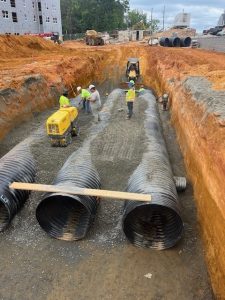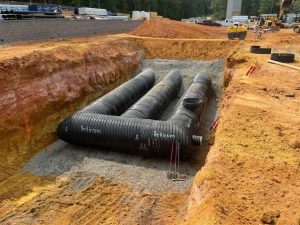By: Lane Enterprises, LLC
The Rise of Apartment Complexes and the Need for Effective Stormwater Management

Across the United States, and particularly in the Mid-Atlantic region, the demand for housing continues to climb. This has fueled a surge in the development of apartment complexes, transforming the landscape of many communities. Lambert Landing, nestled in Chesterfield County, Virginia, just outside of the bustling city of Richmond, is a prime example of this trend. As these developments expand, so too does the critical need for efficient and sustainable stormwater management solutions such as a polymer coated stormwater detention system.
A Transformation in Chesterfield County’s Approach to Stormwater Management
Historically, Chesterfield County heavily favored the use of reinforced concrete pipe (RCP) for stormwater management projects. In fact, just a few years ago, the county’s regulations completely prohibited the use of corrugated steel pipe (CSP). However, a pivotal shift occurred when industry experts were given the opportunity to present the advantages of polymer coated CSP to county officials. This presentation highlighted the durability, longevity, and cost-effectiveness of this innovative material, ultimately persuading the county to reconsider its stance. Today, polymer coated CSP is not only permitted but has become the sole approved CSP material in Chesterfield County. This change has paved the way for numerous successful projects, including sand filters, perforated systems, and conventional detention systems, demonstrating the versatility and effectiveness of polymer coated CSP in addressing diverse stormwater management needs within a polymer coated stormwater detention system.
The Challenge of Costly RCP Designs at Lambert Landing

The initial stormwater design for Lambert Landing relied on a traditional RCP system. This design called for three lateral 60-inch RCP pipes, converging at three large cast-in-place junction chambers. These chambers, essential for connecting the pipes at both ends and the center of the 91-meter (300-foot) long system, posed a significant cost challenge. To accommodate the width of three 60-inch RCP pipes running side-by-side, the concrete chambers had to be a substantial 6 meters (20 feet) wide. The construction of these large chambers added considerable expense to the project, prompting a search for more cost-effective alternatives, such as a polymer coated stormwater detention system.
Polymer Coated CSP: A Cost-Effective and Efficient Solution
Recognizing the potential for improvement, engineers proposed a solution utilizing 60-inch polymer coated CSP. This alternative offered a layout nearly identical to the original RCP design while significantly reducing costs. The key to these savings lay in the ability to eliminate the cumbersome junction chambers altogether. By employing CSP manifolds and specialized fittings, the design achieved the same functionality with a smaller footprint and reduced material requirements. This innovative approach not only streamlined the construction process but also resulted in substantial cost savings, making polymer coated CSP the clear choice for Lambert Landing’s stormwater management system. This successfully demonstrated the advantages of incorporating a polymer coated stormwater detention system.
Related Stories
2022 Project of the Year Winner – Service Life: RT 828 VA
Project Spotlight: Zonguldak Tunnel Project
Polymer Coating